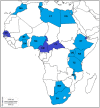Norovirus Epidemiology in Africa: A Review
- PMID: 27116615
- PMCID: PMC4846019
- DOI: 10.1371/journal.pone.0146280
Norovirus Epidemiology in Africa: A Review
Abstract
Norovirus (NoV) is recognised as a leading cause of gastroenteritis worldwide across all age groups. The prevalence and diversity of NoVs in many African countries is still unknown, although early sero-prevalence studies indicated widespread early infection. Reports on NoVs in Africa vary widely in terms of study duration, population groups and size, inclusion of asymptomatic controls, as well as genotyping information. This review provides an estimate of NoV prevalence and distribution of genotypes of NoVs in Africa. Inclusion criteria for the review were study duration of at least 6 months, population size of >50 and diagnosis by RT-PCR. As regions used for genotyping varied, or genotyping was not always performed, this was not considered as an inclusion criteria. A literature search containing the terms norovirus+Africa yielded 74 publications. Of these 19 studies from 14 out of the 54 countries in Africa met the inclusion criteria. Data from studies not meeting the inclusion criteria, based on sample size or short duration, were included as discussion points. The majority of studies published focused on children, under five years of age, hospitalised with acute gastroenteritis. The mean overall prevalence was 13.5% (range 0.8-25.5%) in children with gastroenteritis and 9.7% (range 7-31%) in asymptomatic controls, where tested. NoV GII.4 was the predominant genotype identified in most of the studies that presented genotyping data. Other prevalent genotypes detected included GII.3 and GII.6. In conclusion, NoV is a common pathogen in children with diarrhoea in Africa, with considerable carriage in asymptomatic children. There is however, a paucity of data on NoV infection in adults.
Conflict of interest statement
Figures



References
-
- Green KY. Caliciviridae: The Noroviruses In: Knipe DM, Howley P, editors. Field's Virology. 2 6th ed Philadelphia: Lippincott Williams and Wilkins; 2013. p. 582–608.
-
- Treanor JJ, Atmar RL, Frey SE, Gormley R, Chen WH, Ferreira J, et al. A novel intramuscular bivalent norovirus virus-like particle vaccine candidate—reactogenicity, safety, and immunogenicity in a phase 1 trial in healthy adults. J Infect Dis. 2014;210:1763–71. 10.1093/infdis/jiu337 - DOI - PMC - PubMed
Publication types
MeSH terms
LinkOut - more resources
Full Text Sources
Other Literature Sources
Medical
Research Materials
Miscellaneous

